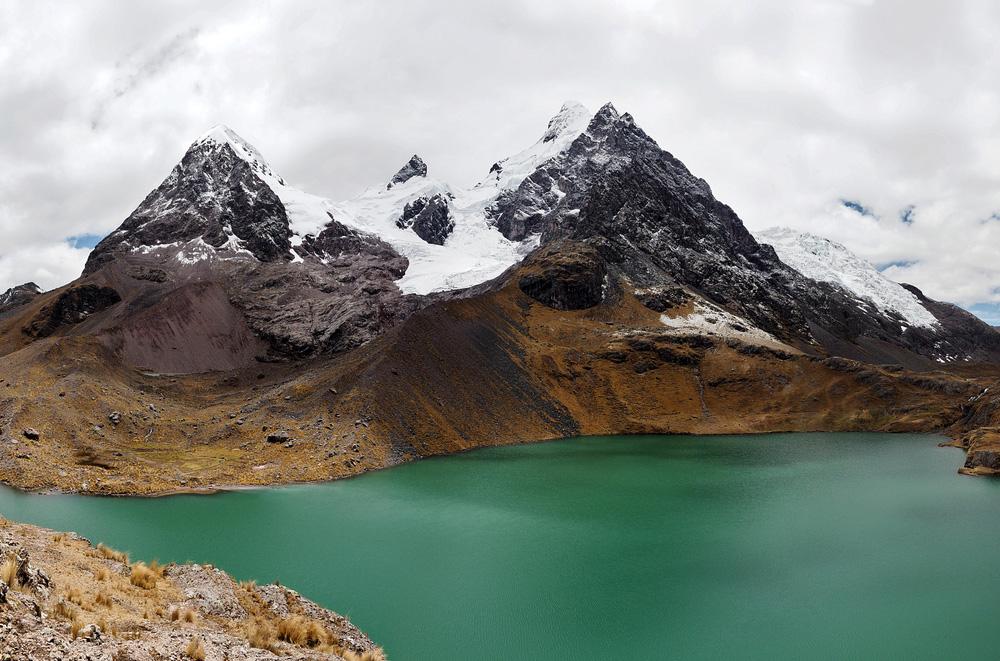Do you know the Nevado Ausangate and it's beautiful 7 Lagoons circuit? This experience connects you with nature itself, tests físical strength and offers you a landscape of remarkable beauty.
At Inca Rail we have a great tour to The 7 Lagoons circuit, and we can not wait to tell you every detail about it so you can include it in your itinerary once you are in Cusco.
What exactly is the Ausangate
Let's start from the beginning, if we are going to talk about the 7 Ausangate Lagoons circuit we must provide all the information you will need about this impressive mountain.
Ausangate is Cusco's second highest mountain, reaching 20948 fit altitud ( 6385 meters above sea level). The snow-capped mountain is located within the Cordillera Vilcanota, which has the most extraordinary mountains and icy lagoons of crystalline waters.
The snow-capped mountain feeds the lagoons that keeps company to the Incas sacred mountain, the same that was considered as a divine being that rules life and death of the andean people, who until today venerate the mountains that protect their world.
What does Ausangate mean?
This snow-capped mountain is the most powerful within the Incas worldview and it is also known as “TheCreator of the Waters”. From its frozen picks is born the Vilcanota (or Willcamayu) River, the same that makes the Sacred Valley of the Incas a very fertile soil and runs until it gets lost in the Peruvian amazon jungle.
Where is located the Ausangate mountain and its 7 lagoons?
The great snow-capped mountain Ausangate and its lagoons are located 62 miles southeast from Cusco city (100 kilometers), within the province of Quispicanchis, district of Ocongate, department of Cusco, Perú.
How to get to the 7 Lagoons circuit?
In order to get to the lagoons of the Ausangate, you must make a bus trip along the road that takes you through the towns of Saylla, Huacarpay, Urcos, Ccatca, Ocongate, Tinke y Pacchanta. From that point forward, you will go walking to the lagoons.
What are the names of the lagoons and at what altitude are they located?
Each one of the 7 Ausangate Lagoons Circuit has a name. Each one is located at different altitudes, very high ones, so you must keep in mind that this is a trek in the middle of the Peruvian puna, where our physical resistance would be tested, that's why you must be prepared for this expedition which has a difficulty level of 4/5.
Pucacocha Lagoon: Is the first one in the circuit. Its name means red lagoon because of the color of its water. The local people also call it Chocolate lagoon. Pucacocha Lagoon is located at 14763 ft. (4500 meters above sea level).
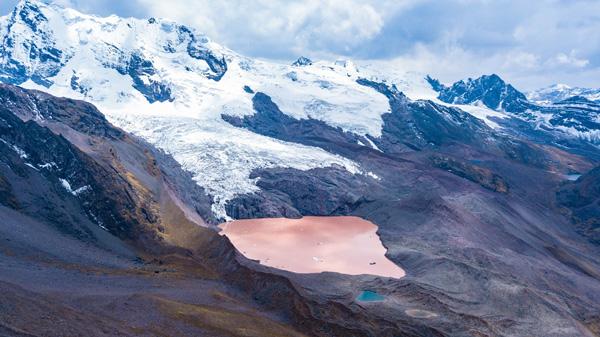
Patacocha Lagoon: This is the second lagoon and it is located 1181 ft. (360 meters) higher than the first one, at 15945 ft. (4860 meters above sea level). As you go forward, the altitude and difficulty of the trek increases, but also the beauty of the landscape and the visibility of the great snow-capped mountain.
Alqacocha Lagoon:The third lagoon is located a little bit lower than Patacocha, but not much. Alqacocha is 15584 ft high (4750 meters above sea level). At this altitude you must have proper hiking clothes because of the extreme weather.
Q’omercocha Lagoon: It is located at 15147 ft (4620 meters above sea level). This is a small lagoon with the shape of an Otorongo. It also has a coloration that follows the spots of the South American feline.
Orco Otorongo Lagoon: it is located at 15147 ft (4620 meters above sea level). This is a small lagoon with the shape of an Otorongo. It also has a coloration that follows the spots of the South American feline.
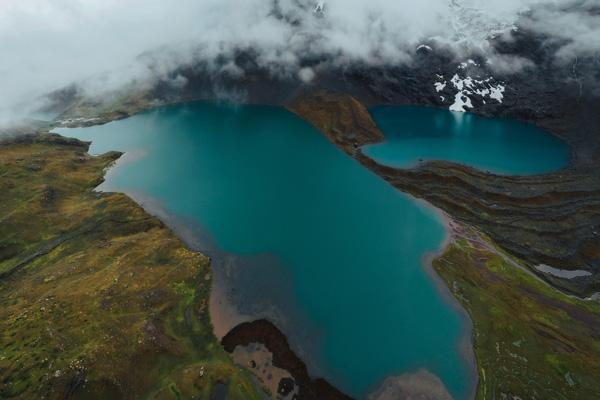
China Otorongo Lagoon: This lagoon is located very close to the previous one and at the same altitude. It is called this way because it is known as a female otorongo. These two lagoons are the best ones for taking pictures that will make you look like a professional photographer.
Azul Cocha Lagoon: It means Blue Lagoon, and if you think that its name came from the color of the water, then you are right. The lagoon has a deep, dark blue color that contrasts sharply with the Ausangate snow-capped mountain. It is located at 15125 ft. (4610 meters above sea level) and it's the last one of the trek.
If you want to visit other lagoons on your trip to Cusco, come with us and take our Humantay Lagoon tour. The amazing landscape and the color of the water will leave you ecstatic.
How is the weather along the trek to Ausangate snow-capped mountain?
If you are thinking about extreme weather during this adventure, then you are absolutely right. That's how it is in the Peruvian puna, Strong winds, low temperatures, a lot of heat and sunlight at times, but definitely nothing you can not manage carrying the proper clothing.
Keep in mind that during the night the cold can reach 14 °F (-10°C) and go up to 17°F (25°C) at the hottest point of the day.
We strongly recommended wearing comfortable clothing, hiking shoes and a good outdoors jacket for this kind of weather, one that's not heavy and you can carry in your backpack.
Don't panic if your nostrils feel funny, the weather is dry and the air is freezing, so it is normal to have some discomfort when inhaling.
Flora and fauna along the road
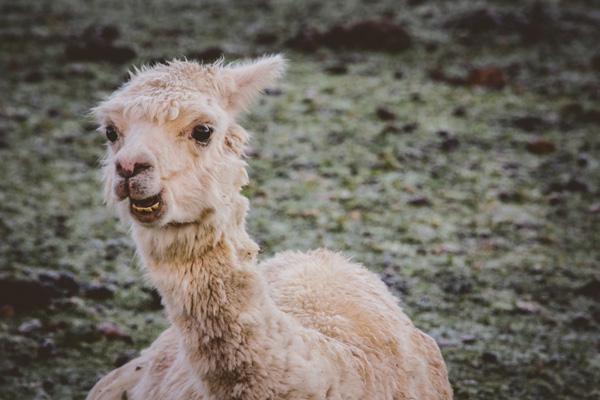
The Peruvian puna landscape is simply wonderful, arid and fertile at the same time. It is a perfect example of balance inside nature. Along the road to Ausangate you will be able to see local vegetation and some animals too, such as Llamas, Alpacas and Vicuñas. If you are lucky you might see a Vizcacha (a small and very fast rodent from this part of the world) or even a bird like the Huallatas, gliding over you and your fellow trekkers with whom you share the adventure. The South American camelids of this area feed on Ichu, a type of thick grass, so strong and resistant that it can survive the extreme weather.
About the route
Although it is a remote and lonely place, the road is very well signposted so you are not in danger of getting lost. You can also find some small stalls along the way where people from nearby communities sell water, coca leaves for altitude sickness and energy and some candy to regain strength. In some cases you can buy scarves, hats or handicrafts that they produce themselves with local materials such as alpaca wool.
Ausangate viewpoint
It is a place on the road from where the snow-capped mountain can be appreciated in all its splendor along with the Pacchanta river and the rest of the wonderful landscape. Next to the viewpoint, the people of the nearby communities offer a very fulfilling experience where they share with travelers some of their ancient customs, such as the spinning of wool or the famous backstrap loom. Also on display are a series of sculptures and models of the mountain and lagoons, as well as some of the animals of the area. Through these experiences, travelers can authentically feel the essence of the people and all the magic of rural destinations.
Pacchanta Thermal Baths
After walking back and forth to this natural treasure, your body will need to rest and relax a little bit, and in Pacchanta you will find thermal baths that are perfect for that porpoise. Surprisingly, the water in the thermal baths comes from the snow-capped mountains, just like the water in the frozen lagoons, but in this case the temperature of the water reaches 104 °F (40°C). This place has a dressing room, toilets and offers you the possibility of buying snacks.
What's the best time of the year to visit The Ausangate 7 Lagoons Circuit?
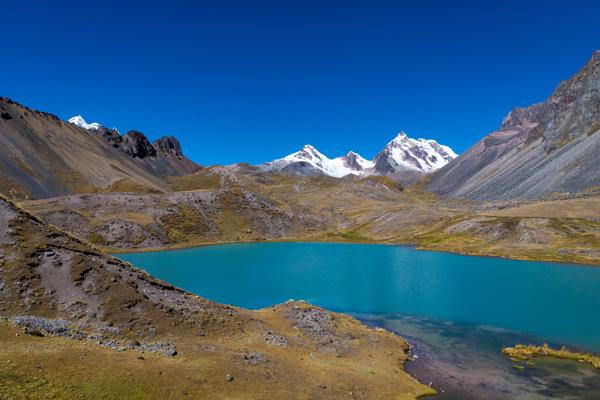
Every time is the best time to travel, to come to Cusco and live the Inca experience, but if you rader be in the mountains in the dry season, come and visit between April and October. The cold weather is more bearable when it is not raining. But just in case, we recommend you to bring a waterproof jacket or a rain poncho, because you never know, ¿right?.
Important thing to remember
- Be sure to drink plenty of water along the walk. Because of the great effort you are about to make, your body needs to be hydrated to prevent any discomfort.
- When you travel to Cusco it is a good idea to take it easy the first two days of your trip and let your body get used to the altitud.
- In this adventure to the snow-capped mountain Ausangate, remember that the higher you are, the more intense the cold will be, so wear the correct clothing to avoid a bad experience.
A list of essentials
- Mask
- Backpack
- Water
- Energetic snacks, such as nuts or dry fruit
- Waterproof trekking shoes
- Hiking clothing, hat and gloves
- Waterproof jacket or rain poncho
- Sunglasses
- Sunscreen lotion
- Toilet paper
- Personal alcohol dispenser
- Extra charged battery for your phone and camera
- Swim suit and a towel in case you want to try the thermal baths
- Cash
If you already decide to live this incredible Inca experience, do it with us. Click in our tourist package Ausangate 7 Lagoons Circuit, reserve your space and leave everything in our hands. Remember that:
- The total hiking distance is 4 miles ( 6.5 km.)
- The time of the hike is 3.5 hours.
- The minimum altitude is 12400 ft. (3780 masl)
- The maximum altitude is 15600 ft. (4750 masl)
- The degree of difficulty of this experience is 4 out of 5.
Ready?. Starting in 3, 2, 1…

